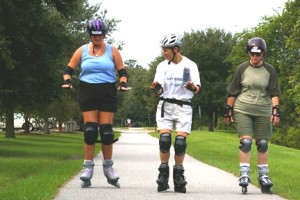“Frankly,” he confided, “I’ve been doing this sport for so long, I can’t really empathize with her learning issues.” The truth comes out.
The instructor’s perspective counts
What a difference the teacher’s level of empathy makes to the beginner who is at the bottom of the skills ladder, where each stance, each movement must be learned from scratch in the proper sequence to build one skill at a time …to just feel safe skating on a local trail …to dance through slalom cones.
It’s not really the instructor’s fault. Skating is learned over time like other sports that require a lot of practice to gain incremental achievements in muscle memory, bit by bit. Subtle adjustments in positioning and balance are constantly taking place in the body without conscious awareness. Once we find success, it’s easy to forget how it all came together, especially if we aren’t paying constant attention.
Seeking the beginner’s perspective
Skating instructors all know that building muscle memory through repeated practice and drills builds the coordination that ultimately delivers success with even the most complex moves.
However, we are often challenged by the extraordinary needs of a seemingly hopeless skating student. “How could he be so stiff?” “Why can’t I get her to shift her weight to the rear skate?” Instructors with a level 2 certification are equipped to detect and correct most stance issues. But often what’s more important is refining what is going on in the hidden core muscles that have so much influence on sports motion. Most important of all, is your attitude.
Here are three key tips for dealing the most challenging student needs:
1. Do you use the word “just”? As in, “Just narrow your stance…” or “Just shift your weight…” This is a dead give-away that you are not on the same page as your student. If he or she could “just” do anything, they’d be doing it already! So just stop saying “just.”
2. Are you right-foot dominant? (or left?) The reward for favoring a foot or a direction is effortless and even thoughtless performance. That is a detriment to teaching, however. Take some time to perform the skill being taught in your “bad” direction. Carefully analyze what’s going on in your body throughout the move so you can better describe and teach it to a struggling student.
3. Is your student unfit? Assign not just lower body exercises such as lunges, but add basic core fitness moves that help the skater strengthen the front, sides and back torso. Suggest Yoga to help the person gain better body awareness: what’s in there and what happens when a particular muscle is tightened or loosened?
My readers may already know that this year I have been struggling as a road biking beginner. I’m amazed at how much I have to learn about weight distribution, core engagement, balance, riding on the road, turning, wobbling, and safe stopping (with clipped-in feet). Boy, do I have renewed empathy for my skating newbies!

Keep the rubber part of road bike in contact with the road..most of the time.